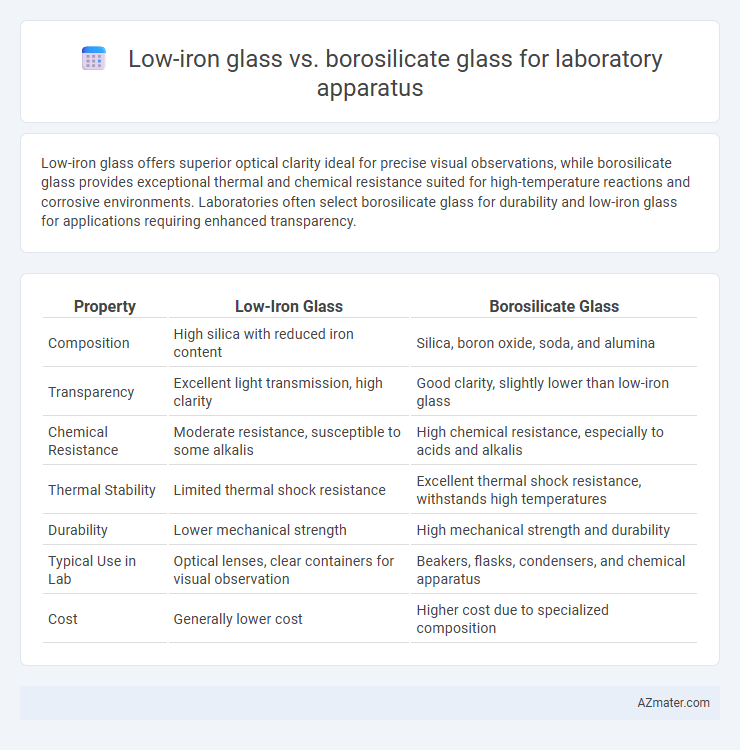Low-iron glass offers superior optical clarity ideal for precise visual observations, while borosilicate glass provides exceptional thermal and chemical resistance suited for high-temperature reactions and corrosive environments. Laboratories often select borosilicate glass for durability and low-iron glass for applications requiring enhanced transparency.
Table of Comparison
| Property | Low-Iron Glass | Borosilicate Glass |
|---|---|---|
| Composition | High silica with reduced iron content | Silica, boron oxide, soda, and alumina |
| Transparency | Excellent light transmission, high clarity | Good clarity, slightly lower than low-iron glass |
| Chemical Resistance | Moderate resistance, susceptible to some alkalis | High chemical resistance, especially to acids and alkalis |
| Thermal Stability | Limited thermal shock resistance | Excellent thermal shock resistance, withstands high temperatures |
| Durability | Lower mechanical strength | High mechanical strength and durability |
| Typical Use in Lab | Optical lenses, clear containers for visual observation | Beakers, flasks, condensers, and chemical apparatus |
| Cost | Generally lower cost | Higher cost due to specialized composition |
Introduction to Laboratory Glassware Materials
Low-iron glass offers superior clarity and minimal greenish tint, making it ideal for precise optical observations in laboratory apparatus. Borosilicate glass is favored for its excellent thermal resistance and chemical durability, suitable for handling high temperatures and aggressive chemicals. Choosing between low-iron and borosilicate glass depends on the specific requirements of optical clarity versus thermal and chemical stability in laboratory settings.
What is Low-Iron Glass?
Low-iron glass, also known as extra-clear glass, contains significantly reduced iron oxide content compared to standard glass, providing superior clarity and enhanced light transmission. This composition reduces the greenish tint common in regular glass, making it ideal for laboratory apparatus where optical clarity is critical for accurate observations and measurements. In contrast, borosilicate glass features high thermal and chemical resistance, but low-iron glass excels specifically in applications requiring maximum transparency and minimal light distortion.
What is Borosilicate Glass?
Borosilicate glass is a type of glass known for its exceptional thermal resistance and chemical durability, making it ideal for laboratory apparatus that require high heat tolerance and resistance to chemical corrosion. It contains boron trioxide, which enhances its ability to withstand sudden temperature changes without cracking, unlike low-iron glass. This composition ensures borosilicate glass is preferred in laboratory settings for beakers, flasks, and test tubes, where precise and safe reactions are crucial.
Chemical Resistance: Low-Iron Glass vs Borosilicate Glass
Low-iron glass offers moderate chemical resistance but is primarily valued for its high optical clarity, which is less critical in laboratory settings. Borosilicate glass exhibits superior chemical resistance, particularly against acids, bases, and thermal shock, making it the preferred choice for laboratory apparatus exposed to harsh chemicals. The enhanced durability and resistance to corrosion of borosilicate glass ensure longer-lasting performance in demanding lab environments compared to low-iron glass.
Thermal Durability and Heat Resistance Comparison
Low-iron glass offers enhanced optical clarity but has lower thermal durability compared to borosilicate glass, which is renowned for its superior heat resistance and thermal shock tolerance, making it ideal for laboratory apparatus exposed to rapid temperature changes. Borosilicate glass withstands temperatures up to approximately 500degC and resists thermal expansion better due to its low coefficient of thermal expansion (~3.3 x 10^-6 /degC), while low-iron glass typically endures lower thermal stress and is more prone to cracking under sudden heat fluctuations. Laboratories requiring durable glassware for high-temperature applications prioritize borosilicate for its reliable performance and safety under thermal duress.
Optical Clarity and Light Transmission
Low-iron glass provides superior optical clarity and higher light transmission rates compared to standard borosilicate glass, making it ideal for applications requiring precise visual observation. Borosilicate glass, while chemically resistant and thermally stable, contains iron impurities that slightly reduce transparency and alter light transmission. Laboratories demanding optimal optical performance often select low-iron glass to ensure minimal color distortion and maximum light passage during experiments.
Mechanical Strength and Durability
Low-iron glass offers high optical clarity but generally has lower mechanical strength compared to borosilicate glass, which is known for its superior thermal resistance and mechanical durability. Borosilicate glass withstands thermal shocks and mechanical stress better, making it the preferred choice for laboratory apparatus requiring frequent heating and cooling cycles. The enhanced chemical durability and resistance to breakage of borosilicate glass provide longer service life in demanding lab environments.
Cost and Availability for Laboratory Use
Low-iron glass offers a cost-effective option for laboratory apparatus due to its lower raw material and manufacturing expenses compared to borosilicate glass. Borosilicate glass, known for its superior thermal and chemical resistance, tends to be more expensive and less widely available in some markets, which can impact procurement timelines. Laboratories with budget constraints and general-purpose applications may prefer low-iron glass, while those requiring higher durability and thermal shock resistance typically invest in the more costly borosilicate variants.
Typical Applications in Laboratory Settings
Low-iron glass is commonly used in laboratory settings requiring high optical clarity and minimal iron contamination, such as spectrophotometry and analytical instruments. Borosilicate glass is preferred for general-purpose laboratory apparatus like beakers, flasks, and condensers due to its superior thermal resistance and chemical durability. Both materials serve distinct roles; low-iron glass excels in optical applications while borosilicate glass is favored for heat-intensive and corrosive environments.
Choosing the Right Glass for Laboratory Apparatus
Low-iron glass offers superior clarity and minimal tint, making it ideal for precise visual observations in laboratory apparatus, while borosilicate glass is valued for its excellent thermal resistance and chemical durability. Borosilicate glass withstands rapid temperature changes and corrosive chemicals, ensuring longevity and safety in high-stress lab environments. Selecting the right glass depends on balancing clarity needs with thermal and chemical resistance requirements to optimize performance and reliability in laboratory applications.

Infographic: Low-iron glass vs Borosilicate glass for Laboratory apparatus
 azmater.com
azmater.com